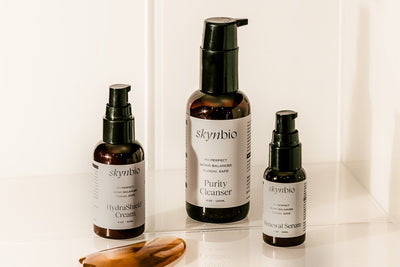When your skincare routine is on point but breakouts persist, your diet might be the missing link. Fungal acne (Malassezia folliculitis) isn’t traditional acne—it’s triggered by a yeast overgrowth on the skin. And just like yeast thrives in sugary, oily environments in the kitchen, it can do the same on and within your body.
At Skynbio, we believe skin health is both topical and internal. In this post, we’ll walk you through what to watch out for, what to include, and why—so you can support clearer, calmer skin from the inside out.
What Fungal Acne Is (and Isn’t)
Fungal acne is often mistaken for bacterial acne, but it stems from an overgrowth of Malassezia, a yeast naturally found on the skin. When triggered, it can cause small, uniform, sometimes itchy bumps—commonly on the forehead, chest, and back.
Foods That May Worsen Fungal Acne
Some foods can feed Malassezia from the inside out. Consider limiting:
- High-sugar foods (sodas, candies, processed desserts)
- Refined carbs (white bread, pastries, pasta)
- Dairy products, especially milk and soft cheeses
- Fermented drinks like kombucha and beer (and some vinegars)
- Peanuts and pistachios (prone to molds that may aggravate yeast)
These choices can disrupt gut balance, encourage internal yeast growth, and show up as external flare-ups.
Yeast-Balancing, Anti-Inflammatory Foods to Favor
Support a calmer internal environment with:
- Leafy greens and colorful vegetables
- Lower-sugar fruits like berries and green apples
- Lean proteins (chicken, turkey, fish)
- Whole-food fats such as avocado and olive oil
- Herbs & spices like turmeric, oregano, and garlic
These choices can help stabilize blood sugar, reduce inflammation, and discourage yeast overgrowth internally.
The Gut–Skin Connection
Antibiotics, stress, and an imbalanced diet can disrupt the microbiome, allowing yeasts like Malassezia and Candida to flourish. Consider integrating:
- Prebiotic-rich foods (bananas, oats, asparagus)
- Plenty of water to support regular detox pathways
- Targeted supplements (e.g., zinc or antifungal botanicals) with professional guidance
How to Test What Works for You
Diet changes aren’t overnight fixes. Try a short elimination (2–3 weeks), then reintroduce one item at a time while tracking your skin’s response.
- Keep a simple food + skin journal
- Note timing, severity, and location of any flare-ups
Helpful Daily Habits
- Cook at home when possible to avoid hidden sugars and oils
- Choose whole, minimally processed ingredients
- Go easy on alcohol—especially beer and wine
- Support stress resilience with sleep and mindfulness
Common Mistakes to Avoid
- Adding fermented probiotic drinks without considering fungal acne
- Using whey-based protein powders (dairy)
- Overdoing nuts and oils without knowing their triggers
Bottom Line
While fungal acne shows up on the surface, triggers often start from within. Aligning your diet with your skin’s needs—and pairing it with topical care—can calm flare-ups more effectively.
Start with the Clear Balance Trio
Skynbio supports a holistic approach with microbiome-smart, oil-free products that avoid common triggers and help restore your barrier. Our Purity Cleanser, Renewal Serum, and HydraShield Moisturizer are gentle, effective, and safe for reactive, acne-prone, and fungal-sensitive skin types.




